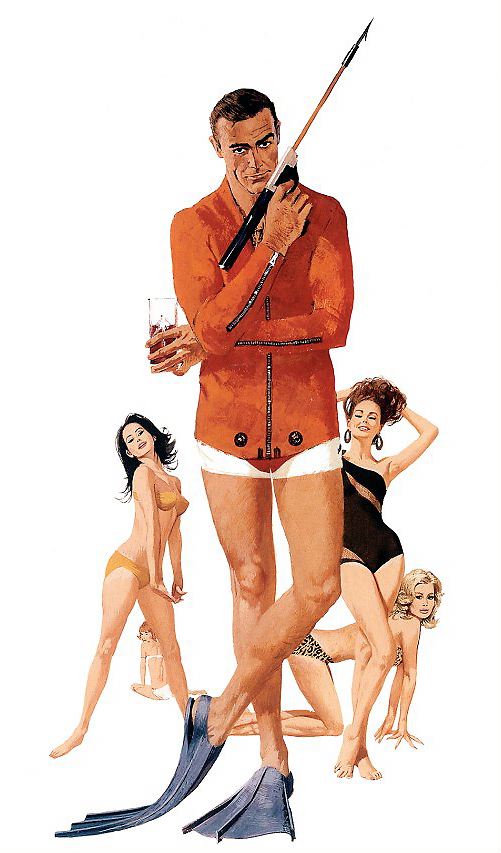
Thunderball
Calm Down, Mr. Bond (Netherlands)
Fireball (Germany)
Fireball (Germany)
Released: 1965
Produced by: EON, Kevin McClory
Best line:
Bond: "That gun. Looks more fitting for a woman."
Largo: "You know much about guns, Mr. Bond?"
Bond: "No. I know a little about women."
Worst line:
Bond: "See you later... irrigator." (at the health clinic; this line was actually from the book)
Good Cut
The pre-credits sequence featuring Bond and the widow originally was written to
take place in an Oriental strip club. The villain was posing as a cabaret girl
dressed in a peacock costume, performing in a large cage.
(You know, because if you're a man wanted for murder by the government and are trying to lay low, the best place to do it is dancing as a woman in a cage in a strip club.)
Undercover
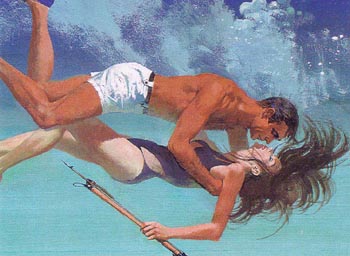 |
Connery's wife wasn't afraid of hitting back, either. Connery's friend Michael Caine: "I remember when I was with them in Nassau. Diane was cooking lunch, and Sean and I went out. Of course, we got out and one thing led to another, you know, and we got back for lunch two hours later. Well, we opened the door and Sean said, 'Darling, we're home' -- and all the food she'd cooked came flying through the air at us. I remember the two of us, standin' there, covered in gravy and green beans."
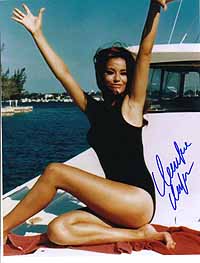 |
Raquel Welch was then signed, but Broccoli reluctantly released her from her contract when she won the starring role in Fantastic Voyage.
Faye Dunaway was the third choice, but did The Happening instead.
 |
As with many of the other Bond women, the voice you hear is not hers: Claudine's voice was dubbed by lawyer Nikki van der Zyl. The voice or accent was never a determining factor in the casting of Bond women:
 |
Title Designer Maurice Binder: "We had all these girls nude, swimming underwater, mostly in silhouette. But at the time, in Spain, during the Franco period, censorship was very strict. The whole title sequence was simply cut from the film. They just flashed names on the screen."
The budget was $5,500,000 ($500,000 of which was spent on Largo's yacht, the Disco Volante). Still, stuntman Bill Cumming was only paid a $450 bonus to jump into Largo's shark infested pool.
Molly Peters (Patricia Fearing) was the first Bond girl to appear in the nude (albeit behind shower glass). On Connery's behavior towards her, Peters said; "He was lovely to work with. Very brotherly to me, because it was my first big part and I was desperately nervous - not only of the lines, but because there were these sexy bed and shower scenes I had to do, one where I was nude with him. Yet he encouraged and never showed impatience... even when some eight takes of the nude shower scene were done."
Molly Peters: "For the shower scene, the makeup people wanted to use sticking-plaster on my pubic area and nipples, which I thought more obscene, if anything. In the end, they just covered my front. And my bottom, of course, was bare for the scene where Connery presses me against the glass and you see the outline. When it was over, Sean came out on all fours, gaga, with a bowler hat on."
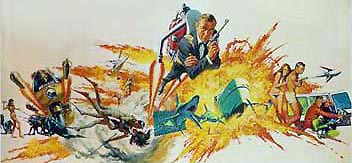 "Thunderball"
is reportedly Sean Connery's favorite Bond film. And there were many reasons for
it, but one of the biggest might have been the women in the film. He was romantically
linked to a lot of them:
"Thunderball"
is reportedly Sean Connery's favorite Bond film. And there were many reasons for
it, but one of the biggest might have been the women in the film. He was romantically
linked to a lot of them:
Molly Peters says she observed Connery's "attraction to glamorous women on the set." She added: "Sean's attention was absorbed by Claudine. He went for continental types, and she suited him ideally."
Rumors of an affair between Connery and Auger ran rampant, causing him to move out of the house he shared with wife, Diane Cilento, and into an apartment. Auger would only say: "Whatever I am doing, I enjoy doing it - loving, driving, riding..."
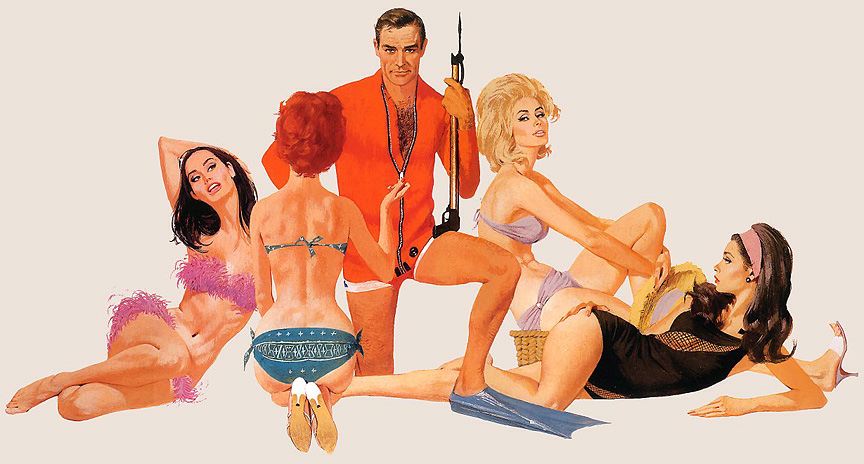
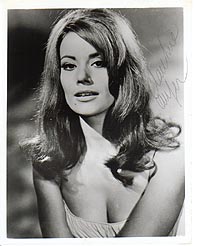 |
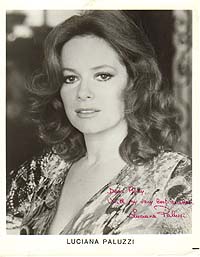 |
But Broccoli and Salzman never let character confusion get in the way of casting hot babes for their movies. And Auger and Paluzzi were DEFINITELY both hot babes. (And judging by the reviews and film grosses, Broccoli and Salzman were right not to worry that the physical similarity would hurt the film.)
The film had a complex production, with four different units and about a quarter of the film consisting of underwater scenes.[1]Thunderball was the first Bond film shot in widescreen Panavision and the first to have over a two-hour running time.
Thunderball was associated with a legal dispute in 1961 when former Ian Fleming collaborators Kevin McClory and Jack Whittingham sued him shortly after the 1961 publication of the novel, claiming he based it upon the screenplay the trio had earlier written in a failed cinematic translation of James Bond. The lawsuit was settled out of court and Bond film series producers Albert R. Broccoli and Harry Saltzman, fearing a rival McClory film, allowed him to retain certain screen rights to the novel's story, plot and characters,[2] and for McClory to receive sole producer credit on this film.
The film was a success, earning a total of $141.2 million worldwide, exceeding the earnings of the three previous Bond films. In 1966, John Stears won the Academy Award for Best Visual Effects[3] and production designer Ken Adam was also nominated for a BAFTA award.[4] Thunderball was the most financially successful movie of the series after adjusting for inflation. Some critics and viewers showered praise on the film and branded it a welcome addition to the series, while others complained of the repetitively monotonous aquatic action and prolonged length. In 1983, Warner Bros. released a second film adaptation of the novel under the title Never Say Never Again, with McClory as executive producer.
[edit] Legal disputes
 Jack and Margot Whittingham head into court. |
The sources for Thunderball are controversial among film aficionados. In 1961, Ian Fleming published his novel based upon a television screenplay that he, and others developed into the film screenplay; the efforts were unproductive, and Fleming expanded the script into his ninth James Bond novel. Consequently, one of his collaborators, Kevin McClory, sued him for plagiarism; they settled out of court in 1963.[12]
Later, in 1964, Eon producers Broccoli and Saltzman agreed with McClory to cinematically adapt the novel; it was promoted as "Ian Fleming's Thunderball". Yet, along with the official credits to screenwriters Richard Maibaum and John Hopkins, the screenplay is also identified as based on an original screenplay by Jack Whittingham and as based on the original story by Kevin McClory, Jack Whittingham, and Ian Fleming.[11] To date, the novel has twice been adapted cinematically; the 1983 Jack Schwartzman-produced Never Say Never Again, features Sean Connery as James Bond, but is not an Eon production.
[edit] Casting
Broccoli's original choice for the role of Domino Derval was Julie Christie following her performance in Billy Liar in 1963. Upon meeting her personally, however, he was disappointed and turned his attentions towards Raquel Welch after seeing her on the cover of the October 1964 issue of Life magazine. Welch, however, was hired by Richard Zanuck of 20th Century Fox to appear in the film Fantastic Voyage the same year instead. Faye Dunaway was also considered for the role and came close to signing for the part.[13] Saltzman and Broccoli auditioned an extensive list of relatively unknown European actresses and models including former Miss Italy Maria Grazia Buccella, Yvonne Monlaur of the Hammer horror films and Gloria Paul. Eventually former Miss France Claudine Auger was cast, and the script was rewritten to make her character French rather than Italian, although her voice was dubbed. Nevertheless, director Young would cast her once again in his next film, Triple Cross (1966). One of the actresses that tried for Domino, Luciana Paluzzi, later accepted the role as the redheaded femme fatale assassin Fiona Kelly who originally was intended by Maibaum to be Irish. The surname was changed to Volpe in coordination with Paluzzi's nationality.[13]
[edit] Filming

Guy Hamilton was invited to direct, but considered himself worn out and "creatively drained" after the production of Goldfinger.[1] Terence Young, director of the first two Bond films, returned to the series. Coincidentally, when Saltzman invited him to direct Dr. No, Young expressed interest in directing adaptations of Dr. No, From Russia With Love and Thunderball. Years later, Young said Thunderball was filmed "at the right time",[14] considering that if it was the first film in the series the short budget Ñ Dr. No cost only $1 million Ð wouldn't have good results.[14] Thunderball was the final James Bond film directed by Young.
Connery's life was in danger in the sequence with the sharks in Largo's pool and one which he had been in fear of when he read the script. He insisted that Ken Adam build a special Plexiglas partition inside the pool but, despite this, it was not a fixed structure and one of the sharks managed to pass through it. Connery had to abandon the pool immediately, seconds away from attack.[15] Another dangerous situation occurred when special effects coordinator John Stears brought in a supposed dead shark carcass to be towed around the pool. The shark, however, was not dead and revived at one point. Due to the dangers on the set, stuntman Bill Cummings demanded an extra fee £250 to double for Largo's sidekick Quist as he was dropped into the pool of sharks.[13]

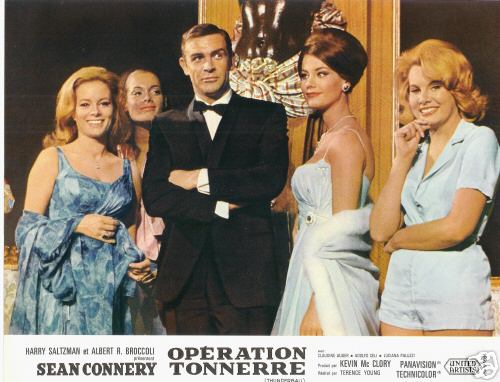
From left: Luciana Paluzzi, Martine Beswick, Sean Connery, Claudine Auger, and Molly Peters.

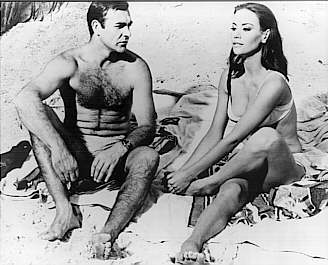
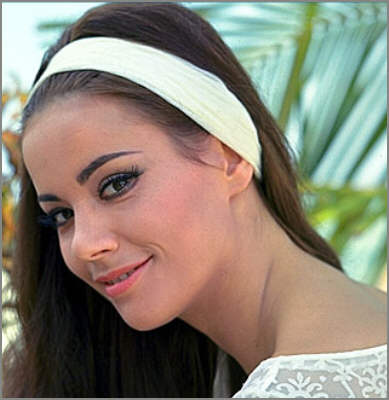



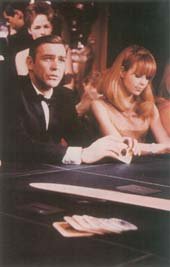
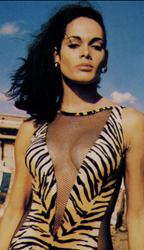
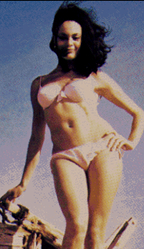
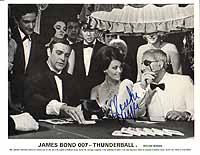
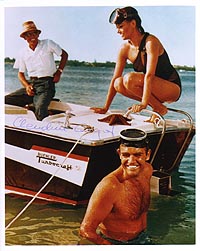
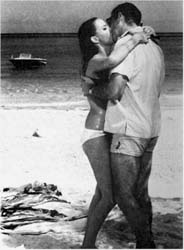
| Films, main | The Sixties |


